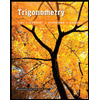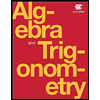2π -1 Cos | =0 sin %3D 3
Trigonometry (11th Edition)
11th Edition
ISBN:9780134217437
Author:Margaret L. Lial, John Hornsby, David I. Schneider, Callie Daniels
Publisher:Margaret L. Lial, John Hornsby, David I. Schneider, Callie Daniels
Chapter1: Trigonometric Functions
Section: Chapter Questions
Problem 1RE:
1. Give the measures of the complement and the supplement of an angle measuring 35°.
Related questions
Question
![### Trigonometric Expression Simplification
**Problem Statement:**
\[ \sin^{-1}\left(\cos\left(\frac{2\pi}{3}\right)\right) = \]
**Instructions:**
(Simplify your answer. Type an exact answer, using \(\pi\) as needed. Use integers or fractions for any numbers in the expression.)
**Explanation:**
The task involves simplifying the given trigonometric expression which includes the inverse sine function (also known as arcsine) and a cosine function involving \(\pi\).
1. **Start by finding \(\cos\left(\frac{2\pi}{3}\right)\):**
\(\cos\left(\frac{2\pi}{3}\right)\) is a known value on the unit circle. The angle \(\frac{2\pi}{3}\) corresponds to 120 degrees. At this angle:
\[
\cos\left(\frac{2\pi}{3}\right) = -\frac{1}{2}
\]
2. **Next, find \(\sin^{-1}\left(-\frac{1}{2}\right)\):**
The value \( -\frac{1}{2} \) falls within the range of the inverse sine function, which is \([-1, 1]\).
The sine of which principal angle is \( -\frac{1}{2} \)? The principal value range for the arcsine function (\(\sin^{-1}\)) is \( \left[ -\frac{\pi}{2}, \frac{\pi}{2} \right] \).
\[
\sin^{-1}\left(-\frac{1}{2}\right) = -\frac{\pi}{6}
\]
**Final Answer:**
\[ \sin^{-1}\left(\cos\left(\frac{2\pi}{3}\right)\right) = -\frac{\pi}{6} \]
Feel free to verify and supplement this explanation with unit circle visuals or additional examples for further clarity.](/v2/_next/image?url=https%3A%2F%2Fcontent.bartleby.com%2Fqna-images%2Fquestion%2F56b89a6c-6ca3-4f25-9a44-1409c69966fc%2F1eee4f8b-69e8-4cfd-8ce7-e4349e43cc93%2F42dvzu_processed.png&w=3840&q=75)
Transcribed Image Text:### Trigonometric Expression Simplification
**Problem Statement:**
\[ \sin^{-1}\left(\cos\left(\frac{2\pi}{3}\right)\right) = \]
**Instructions:**
(Simplify your answer. Type an exact answer, using \(\pi\) as needed. Use integers or fractions for any numbers in the expression.)
**Explanation:**
The task involves simplifying the given trigonometric expression which includes the inverse sine function (also known as arcsine) and a cosine function involving \(\pi\).
1. **Start by finding \(\cos\left(\frac{2\pi}{3}\right)\):**
\(\cos\left(\frac{2\pi}{3}\right)\) is a known value on the unit circle. The angle \(\frac{2\pi}{3}\) corresponds to 120 degrees. At this angle:
\[
\cos\left(\frac{2\pi}{3}\right) = -\frac{1}{2}
\]
2. **Next, find \(\sin^{-1}\left(-\frac{1}{2}\right)\):**
The value \( -\frac{1}{2} \) falls within the range of the inverse sine function, which is \([-1, 1]\).
The sine of which principal angle is \( -\frac{1}{2} \)? The principal value range for the arcsine function (\(\sin^{-1}\)) is \( \left[ -\frac{\pi}{2}, \frac{\pi}{2} \right] \).
\[
\sin^{-1}\left(-\frac{1}{2}\right) = -\frac{\pi}{6}
\]
**Final Answer:**
\[ \sin^{-1}\left(\cos\left(\frac{2\pi}{3}\right)\right) = -\frac{\pi}{6} \]
Feel free to verify and supplement this explanation with unit circle visuals or additional examples for further clarity.
Expert Solution
This question has been solved!
Explore an expertly crafted, step-by-step solution for a thorough understanding of key concepts.
Step by step
Solved in 2 steps with 2 images

Knowledge Booster
Learn more about
Need a deep-dive on the concept behind this application? Look no further. Learn more about this topic, trigonometry and related others by exploring similar questions and additional content below.Recommended textbooks for you

Trigonometry (11th Edition)
Trigonometry
ISBN:
9780134217437
Author:
Margaret L. Lial, John Hornsby, David I. Schneider, Callie Daniels
Publisher:
PEARSON

Trigonometry (MindTap Course List)
Trigonometry
ISBN:
9781305652224
Author:
Charles P. McKeague, Mark D. Turner
Publisher:
Cengage Learning


Trigonometry (11th Edition)
Trigonometry
ISBN:
9780134217437
Author:
Margaret L. Lial, John Hornsby, David I. Schneider, Callie Daniels
Publisher:
PEARSON

Trigonometry (MindTap Course List)
Trigonometry
ISBN:
9781305652224
Author:
Charles P. McKeague, Mark D. Turner
Publisher:
Cengage Learning


Trigonometry (MindTap Course List)
Trigonometry
ISBN:
9781337278461
Author:
Ron Larson
Publisher:
Cengage Learning